by Annalisa Giacinti, studio photos by Curtis Hughes // June 13, 2023
When I arrive at her studio, on a very warm and sunny afternoon in May, I’m five minutes too early, Monika Grabuschnigg points out jokingly. She needed the spare time to wipe specks of varnish off a ceramic replica of a fridge door that got spotted with white paint when the studio’s ceilings were being freshly coated.
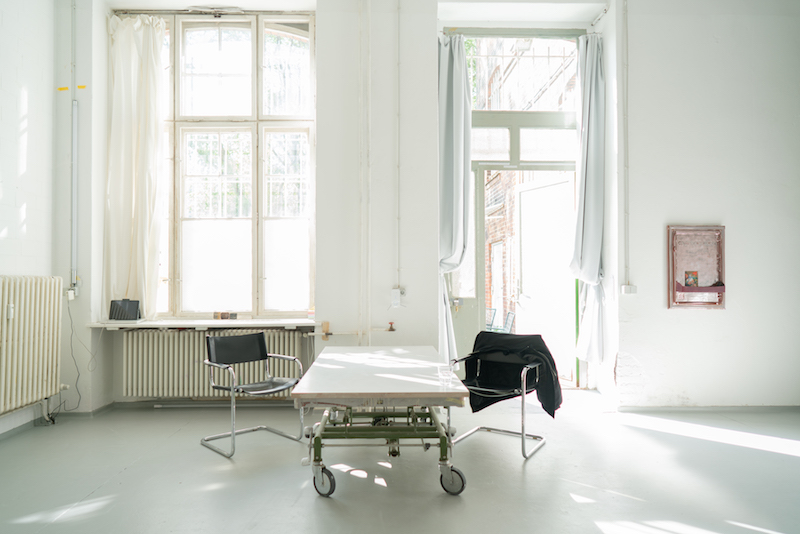
Her space is on the ground floor of a back courtyard building in Wedding, and it opens to a private backyard. Despite the bustling main road the front house faces, the artist is able to tuck herself away in her own private haven, where she spends almost every day working, and reads in the evenings. In her daily routine, which involves creation (she cultivates different projects at once) as well as administrative tasks, Grabuschnigg seems disciplined and keen on avoiding distractions: her name is not on the doorbell, and her phone is often on flight mode. She relocated here two and a half years ago, just before the pandemic hit, and found a placid oasis for contemplation, research and creative exchange with friends and colleagues that visit her regularly.
Grabuschnigg is a Berlin-based artist from Austria, whose practice consists primarily of sculpture and installation, but it includes drawing and painting, too. Lately, her material of choice has been clay, the manufacturing of which is lengthy and quite laborious, and as it takes weeks to dry, so does each piece to be finished. Her art is tangible, and it explores the innermost traits of human life: beliefs, desires, human predispositions that shape the fundamental understanding of ourselves and are explored through the domesticated and commodified objects we latch onto.
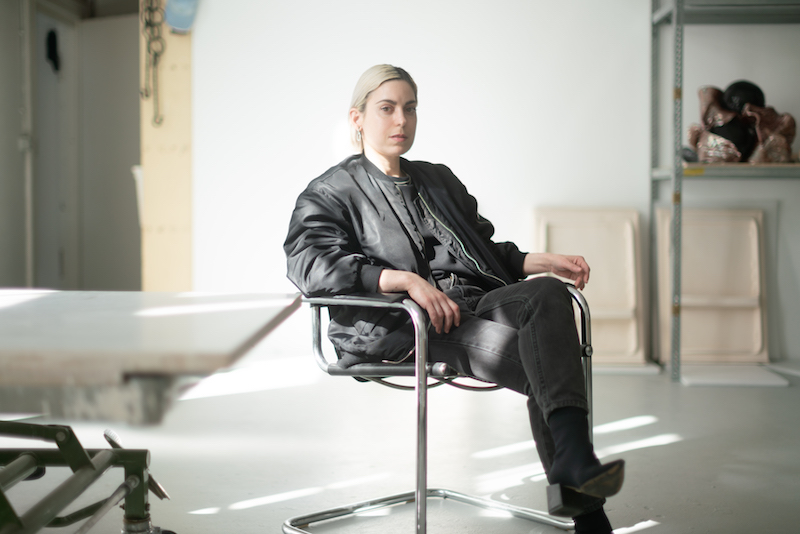
The fridge door is part of her latest series, ‘Single Fridge,’ and when it’s clean and gleaming again, she offers me a glass of water and chocolate-covered hazelnuts, and we sit down to begin our conversation. There are four additional doors sitting on the floor in front of me, which have just returned from the kiln and are ready to be glazed, the artist notes. Once she’s done that, they’ll go back for a second and last round of glaze firing. Everything else is done at the studio. The fridge doors were realised through the technique of slip casting, which, she explains, consists in pouring a liquid mixture of water and clay into a plaster mould. As the water gets absorbed, the slurry dries against the wall of the mould until the final object fully separates and can be removed from it. Two more doors are hanging on contiguous walls. One is covered in a copper-like coat and displays an engraving that reads “crimson eyes,” while the second, cream-coloured, emphatically recites: “Gravely Cold.” I find them intriguing for the way they provocatively flirt with darkness.
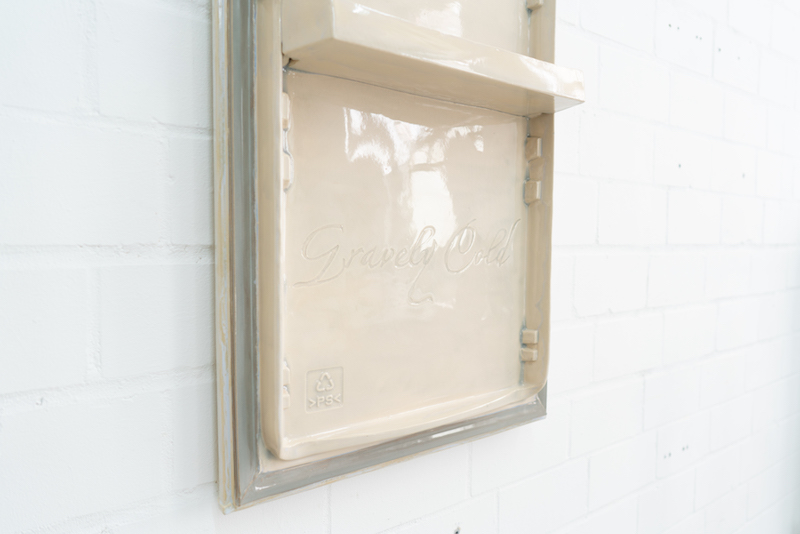
Through this series of work, Grabuschnigg wanted to explore preservation, sadness and melancholia. “A fridge is a domesticated object, and therefore an egalitarian and approachable symbol.” She says this convincingly, hinting at how much politics are an inherent component of her practice, not in the form of an agenda but as a conscious response to her surroundings. It’s also a private object, she adds, especially its inside, which is what she’s decided to show in order to “forge different narratives.” The doors come with a shelf, where she added various artefacts, like casted eye drops, an aluminium egg holder, a tissue box. In addition, the witty writing on them is a clear reference to tombstones. Time, and its fleeting nature, is a theme dear to Grabuschnigg, who has come up with a way to contrast its ravenous spell: refrigeration. “It’s not only that the fridge preserves what’s inside, it also preserves you through the things you put in it.”
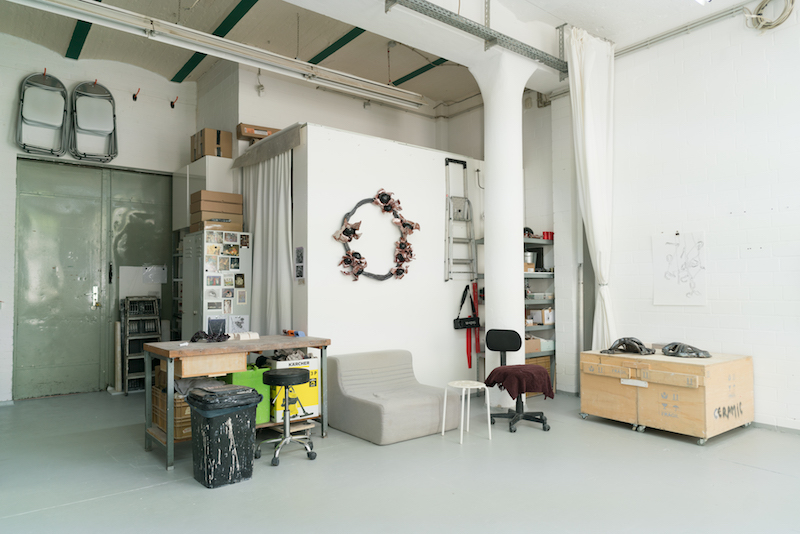
Storing foods and other sorts of items in a fridge is, after all, a way of collecting. It’s the domestic rendition of the construction of an archive, of a personal historical record that negotiates forgetfulness, amnesia, time passing and ultimately death. “Every object has two functions—to be put to use and to be possessed. The first involves the field of the world’s practical totalization by the subject, the second an abstract totalization of the subject undertaken by the subject himself outside the world,” wrote Jean Baudrillard in The System of Objects in 1968. Inspired by psychoanalysis, the French sociologist theorised the practice of collecting describing the effect that it exerts upon the object: when no longer specified by its use, the object’s functionality collapses into subjectivity, turning into a beacon of self-projection, a totalising environment made of images of the self. “For what you really collect is always yourself.” With a trace of irony that relieves her art from the burdensome and solipsistic nature of the matter, Grabuschnigg aptly enacts Baudrillard’s theory and proposes a synthesis of said two functions: it is its very use, preservation, that turns the fridge into a self-referential symbol, a way to affirm a personal present and a past, and promise a future against inevitable loss and decay.
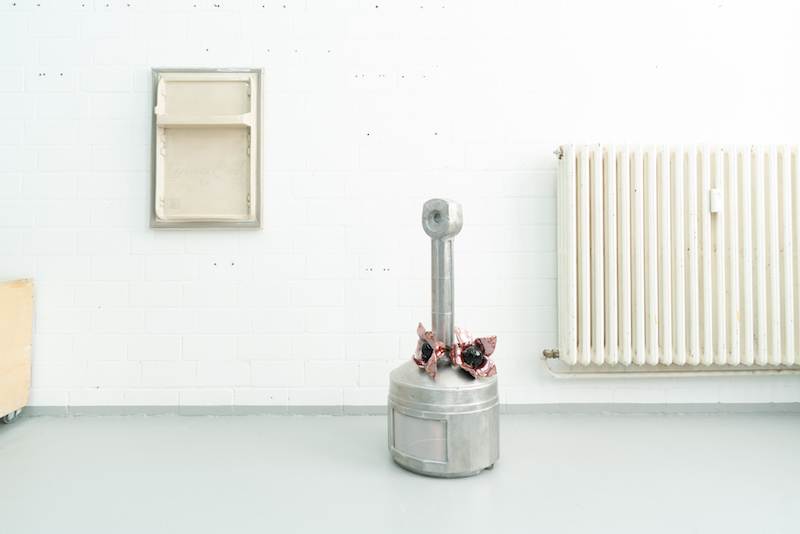
The kind of loss the artist is interested in is not of the nostalgic kind, she makes sure to clarify, but is instead concerned with melancholia, and “the notion that you’re missing something but you have no idea what it is, rather than missing something which was already there once.” She describes a sentiment of unresolved longing and waiting as a “grey area,” a place where one never really achieves complete satisfaction, yet precisely in its liminality it’s “healthy and productive.”
On another wall hangs ‘Wreath,’ a project she developed a year and half ago for a show about the interconnection between human and nature, for which she reproduced the ill-famed black nightshade berries on a larger scale using handbuilt ceramic. “The nightshade is a very interesting fruit because it represents the first time the notions of danger and fear came into my life,” bursting open the narrow circumscription of her “protected area.” Grabuschnigg recalls that deadly berries could be found in great quantities where she grew up, and how often her parents would warn her not to ever pick them up. Though highly poisonous, the plant looked seductive, its flower pretty and berries juicy and appetising.
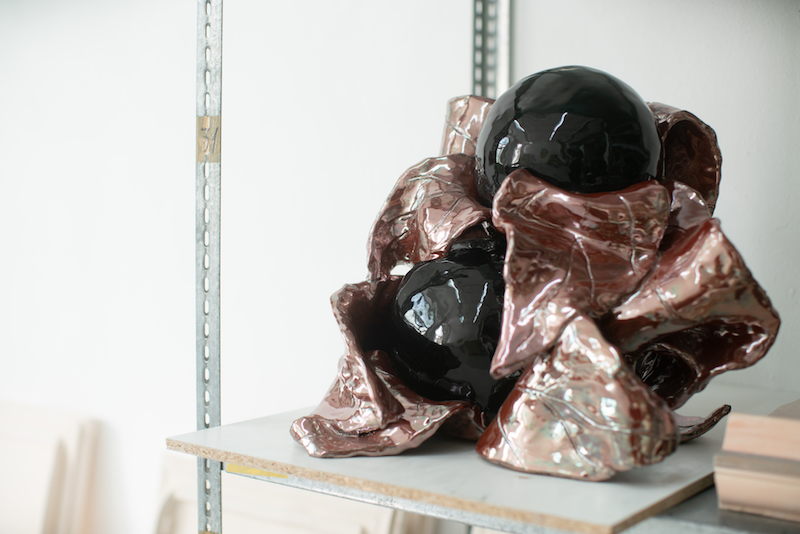
Describing the alleged effect that eating these berries has on humans, Grabuschnigg says: “They open the gate to the other side, so that you’re in between life and death and it must be really hard to come back.” Much like the fridge door/tombstone, the berry too is elevated to a symbolic threshold, a gateway that leads to uncharted realms, the unknown, fear and death. The parallelism between the two projects is not fortuitous, the artist clarifies. She made them simultaneously, exploring the dichotomy between the two spheres they belong to: inside/outside, domesticity/nature.
In her studio there are two more pieces that belong to the series ‘Crash (Simulation),’ made in 2019 for Kunsthalle Wien. The works consist of heat-deformed sculptures that mimic metal hub caps, evoking the imagery of a car crash, and are reflective of the failed dreams of a capitalist society fuelled by speed, acceleration and optimisation. They too are made of glazed ceramic, first casted in moulds and then twisted to reach their final form. “They are almost ironic,” she says in an old interview, “in the sense that they aren’t what they are. At the same time they are fluid, morphic, and also very human.”
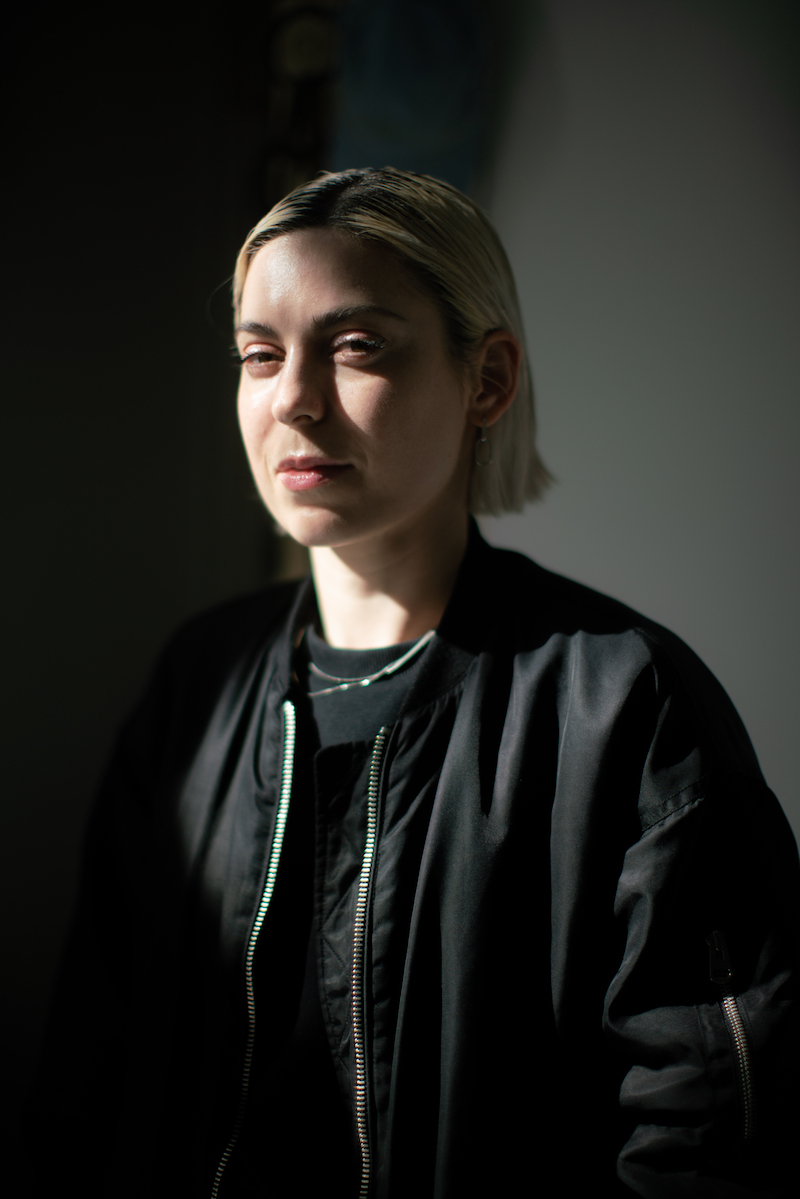
Before I leave, after taking a final peek through her library shelves, I ask Grabuschnigg whether the intensity of the themes she deals with have had a pessimistic impact on her art, and by extension her life, too. “I’m interested in a certain heaviness and resting in it, in trying to bear it and look at it, in staying in a place of grief and longing, entertaining those feelings and being alone with them.” I mention the much talked-about topic of toxic positivity happening on social media, and she calls it “absolutely unhelpful, a constant deflection of a pain that’s healthy and necessary to life.” Ultimately, though, she concedes a little: “Of course, there is optimism, that’s why you get up every morning, no?” In a couple of days she will fly to Dubai where her work will be shown in a duo exhibition at Carbon 12. Once back, she’ll start preparing for an upcoming solo show, where she will present new works made of new materials, like wood. I find her versatility, I think to myself, an instance of optimism, too.
Artist Info
Exhibition Info
Carbon 12
Monika Grabuschnigg and Nour Malas: ‘Four AM’
Exhibition: May 23-Sep. 7, 2023
carbon12.art
Unit 37, Alserkal Avenue, Street 8, Dubai, UAE, click here for map
























